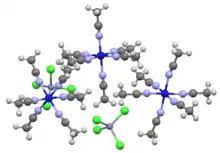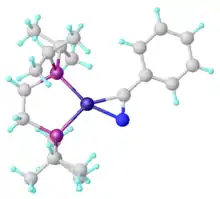Transition metal nitrile complexes
Transition metal nitrile complexes are coordination compounds containing nitrile ligands. Because nitriles are weakly basic, the nitrile ligands in these complexes are often labile.[1]
copper(I)_hexafluorophosphate.png.webp)
Scope of nitriles
Typical nitrile ligands are acetonitrile, propionitrile, and benzonitrile. The structures of [Ru(NH3)5(NCPh)]n+ have been determined for the 2+ and 3+ oxidation states. Upon oxidation the Ru-NH3 distances contract and the Ru-NCPh distances elongate, consistent with amines serving as pure-sigma donor ligands and nitriles functioning as pi-acceptors.[2]
.png.webp)
Synthesis and reactions
Acetonitrile, propionitrile and benzonitrile are also popular solvents. Because nitrile solvents have high dielectric constants, cationic complexes containing a nitrile ligand are often soluble in a solution of that nitrile.
Some complexes can be prepared by dissolving an anhydrous metal salt in the nitrile. In other cases, a suspension of the metal is oxidized with a solution of NOBF4 in the nitrile:[3]
- Ni + 6 MeCN + 2 NOBF4 → [Ni(MeCN)6](BF4)2 + 2 NO
Heteroleptic complexes of molybdenum and tungsten can by synthesized from their respective hexacarbonyl complexes.[4]
- M(CO)6 + 4 MeCN + 2 NOBF4 → [M(NO)2(MeCN)4](BF4)2

For the synthesis of some acetonitrile complexes, the nitrile serves as a reductant. This method is illustrated by the conversion of molybdenum pentachloride to the molybdenum(IV) complex:[6]
- 2 MoCl5 + 5 CH3CN → 2 MoCl4(CH3CN)2 + ClCH2CN + HCl
Reactions
Transition metal nitrile complexes are usually employed because the nitrile ligand is labile and relatively chemically inert. Cationic nitrile complexes are however susceptible to nucleophilic attack at carbon. Consequently some nitrile complexes catalyze the hydrolysis of nitriles to give the amides.[7]
Fe- and Co-nitrile complexes are intermediates in nitrile hydratase enzymes. N-coordination activates the sp-hybridized carbon center toward attack by nucleophiles, including water.[8] Thus coordination of the nitrile to a cationic metal center is the basis for the catalytic hydration:
- M-NCR + H2O → M-O=C(NH2)R
- M-O=C(NH2)R + NCR → O=C(NH2)R + M-NCR
Nitrile ligands in electron-rich complexes are susceptible to oxidation, e.g. by iodosylbenzene.[9] Nitriles undergo coupling with alkenes, also involving electron-rich complexes.[10]
Examples
[M(NCMe)6]n+
- Hexakis(acetonitrile)vanadium(II) tetrachlorozincate ([V(MeCN)6](ZnCl4)), green[11]
- Hexakis(acetonitrile)chromium(II) bis(tetraphenylborate) ([Cr(MeCN)6](B(C6H5)4)2, green[12]
- Hexakis(acetonitrile)chromium(III) tetrafluoroborate ([Cr(MeCN)6](BF4)3), white[13]
- Hexakis(acetonitrile)iron(II) bis(tetrakis(pentafluorophenyl)borate) ([Fe(MeCN)6](B(C6F5)4)2, orange[14]
- Hexakis(acetonitrile)cobalt(II) bis(tetrakis(pentafluorophenyl)borate) ([Co(MeCN)6](B(C6F5)4)2, purple[15]
- Hexakis(acetonitrile)nickel(II) tetrafluoroborate ([Ni(MeCN)6](BF4)2), blue
- Hexakis(acetonitrile)copper(II) bis(tetrakis(pentafluorophenyl)borate) ([Cu(MeCN)6](B(C6F5)4)2, pale blue-green solid[16]
- Hexakis(acetonitrile)ruthenium(II) tetrafluoroborate ([Ru(MeCN)6](BF4)2), white, dRu-N = 202 pm.[17]
- Hexakis(acetonitrile)rhodium(III) tetrafluoroborate ([Rh(MeCN)6](BF4)3), a yellow solid.[18]
- Hexakis(acetonitrile)rhenium(II) tetrafluoroborate ([Re(MeCN)6](BF4)2), a yellow solid.[19]
- Hexakis(acetonitrile)rhenium(III) tetrafluoroborate ([Re(MeCN)6](BF4)3), a brown solid.[19]
[M(NCMe)4]n+
- [Cr(MeCN)4](BF4)2, blue[20]
- [Cu(MeCN)4]PF6, colorless
- [Pd(MeCN)4](BF4)2, yellow[21]
[M(NCMe)4 or 5]2n+
- [Mo2(MeCN)8/10](BF4)4 blue d(Mo-Mo) = 218, d(Mo-N)axial = 260, d(Mo-N)equat = 214 pm[22]
- [Tc2(MeCN)10](BF4)4[23]
- [Re2(MeCN)10][B(C6H3(CF3)2)4]2,[24] blue; d(Re-Re) = 226, d(Re-N)axial = 240, d(Re-N)equat = 205 pm
- [Rh2(MeCN)10](BF4)4, orange; d(Rh-Rh) = 261, d(Re-N)axial = 219, d(Re-N)equat = 198 pm[18]
Mixed ligand examples
- Bis(benzonitrile)palladium dichloride (PdCl2(PhCN)2), an orange solid that serves as a source of "PdCl2"
- Tricarbonyltris(propionitrile)molybdenum(0) (Mo(CO)3(C2H5CN)3), a source of "Mo(CO)3". Related Cr and W complexes are known.[27]
Complexes of η2-nitrile ligands
In some of its complexes, nitriles function as η2-ligands. This bonding mode is more common for complexes of low-valence metals, such as Ni(0). Complexes of η2-nitriles are expected to form as transient intermediates in certain metal-catalyzed reactions of nitriles, such as the Hoesch reaction and the hydrogenation of nitriles. In some cases, η2-nitrile ligands are intermediates that preceded oxidative addition.[28]

See also
- Cyanometalate – coordination compounds containing cyanide ligands (coordinating via C).
References
- Rach, S. F.; Kühn, F. E. (2009). "Nitrile Ligated Transition Metal Complexes with Weakly Coordinating Counteranions and Their Catalytic Applications". Chemical Reviews. 109 (5): 2061–2080. doi:10.1021/cr800270h. PMID 19326858.
- Shin, Yeung-gyo K.; Szalda, David J.; Brunschwig, Bruce S.; Creutz, Carol; Sutin, Norman (1997). "Electronic and Molecular Structures of Pentaammineruthenium Pyridine and Benzonitrile Complexes as a Function of Oxidation State". Inorganic Chemistry. 36 (14): 3190–3197. doi:10.1021/ic9700967. PMID 11669976.
- Heintz, Robert A.; Smith, Jennifer A.; Szalay, Paul S.; Weisgerber, Amy; Dunbar, Kim R. (2002). "Homoleptic Transition Metal Acetonitrile Cations with Tetrafluoroborate or Trifluoromethanesulfonate Anions". Inorg. Synth. 33: 75–83. doi:10.1002/0471224502.ch2.
- Thomas, Richard R.; Sen, Ayusman (2007). "Acetonitrile Complexes of Selected Transition Metal Cations". Inorganic Syntheses. 28: 63–67. doi:10.1002/9780470132593.ch14. ISBN 9780470132593.
- I. Sotofte; R. G. Hazell; S. E. Rasmussen (1976). "Hexaacetonitrilenickel(II) Tetrachlorozincate. A Crystal Structure with Serious Overlap in the Patterson Function". Acta Crystallographica Section B. 32 (6): 1692–1696. doi:10.1107/S0567740876006249.
- Maria, Sébastien; Poli, Rinaldo (2014). "Ether Complexes of Molybdenum(III) and Molybdenum(IV) chlorides". Inorganic Syntheses: Volume 36 (PDF). Inorganic Syntheses. Vol. 36. pp. 15–18. doi:10.1002/9781118744994.ch03. ISBN 9781118744994.
- Pombeiro, A.J.L.; Kukushkin, V.Yu. (2003). "Reactivity of Coordinated Nitriles". Comprehensive Coordination Chemistry II. pp. 639–660. doi:10.1016/B0-08-043748-6/01248-2. ISBN 9780080437484.
- Curtis, Neville J.; Sargeson, Alan M. (1984). "Synthesis and base hydrolysis of pentaammine N,N-dimethylformamide and acetonitrile complexes of rhodium(III) and iridium(III)". Journal of the American Chemical Society. 106 (3): 625–630. doi:10.1021/ja00315a029.
- Cross, Jeffrey L.; Garrett, Andrew D.; Crane, Todd W.; White, Peter S.; Templeton, Joseph L. (2004). "Coordination and reactivity of acetonitrile in tungsten(IV) complexes: Oxidation, methylation and dimerization of coordinated acetonitrile". Polyhedron. 23 (17): 2831–2840. doi:10.1016/j.poly.2004.09.008.
- Cohen, Steven A.; Bercaw, John E. (1985). "Titanacycles derived from reductive coupling of nitriles, alkynes, acetaldehyde, and carbon dioxide with bis(pentamethylcyclopentadienyl)(ethylene)titanium(II)". Organometallics. 4 (6): 1006–1014. doi:10.1021/om00125a008.
- Clemente, Dore Augusto (2005). "A Study of the 8466 Structures Reported in Inorganica Chimica Acta: 52 Space Group Changes and Their Chemical Consequences". Inorganica Chimica Acta. 358 (6): 1725–1748. doi:10.1016/j.ica.2004.10.037.
- Thangavel, Arumugam; Wieliczko, Marika; Scarborough, Christopher; Dittrich, Birger; Bacsa, John (2015). "An Investigation of the Electron Density of a Jahn–Teller-Distorted CrII Cation: The Crystal Structure and Charge Density of Hexakis(acetonitrile-κN)chromium(II) Bis(tetraphenylborate) Acetonitrile Disolvate". Acta Crystallographica Section C: Structural Chemistry. 71 (11): 936–943. doi:10.1107/S2053229615015739. PMID 26524164.
- Hatlevik, Øyvind; Arif, Atta M.; Miller, Joel S. (2004). "Synthesis and Characterization of Hexakis(acetonitrile)chromium(III) Tetrafluoroborate, [CrIII(NCMe)6][BF4]3. A Nonaqueous CrIII Source". Journal of Physics and Chemistry of Solids. 65: 61–63. doi:10.1016/j.jpcs.2003.08.020.
- Musgrave, Rebecca A.; Hailes, Rebekah L. N.; Schäfer, André; Russell, Andrew D.; Gates, Paul J.; Manners, Ian (2018). "New Reactivity at the Silicon Bridge in Sila[1]ferrocenophanes" (PDF). Dalton Transactions. 47 (8): 2759–2768. doi:10.1039/C7DT04593J. hdl:1983/9e6d6454-2797-41d2-a75f-ed90363b5bed. PMID 29417116. S2CID 3406313.
- Hijazi, Ahmed K.; Al Hmaideen, Akef; Syukri, Syukri; Radhakrishnan, Narayanan; Herdtweck, Eberhardt; Voit, Brigitte; Kühn, Fritz E. (2008). "Synthesis and Characterization of Acetonitrile-Ligated Transition-Metal Complexes with Tetrakis(pentafluorophenyl)borate as Counteranions". European Journal of Inorganic Chemistry. 2008 (18): 2892–2898. doi:10.1002/ejic.200800201.
- Hijazi, Ahmed K.; Yeong, Hui Y.; Zhang, Yanmei; Herdtweck, Eberhardt; Nuyken, Oskar; Kühn, Fritz E. (2007). "Isobutene Polymerization Using [CuII(NCMe)6]2+ with Non-Coordinating Anions as Catalysts". Macromolecular Rapid Communications. 28 (5): 670–675. doi:10.1002/marc.200600139.
- Underwood, Christopher C.; Stadelman, Bradley S.; Sleeper, Mark L.; Brumaghim, Julia L. (2013). "Synthesis and Electrochemical characterization of [Ru(NCCH3)6]2+, Tris(acetonitrile) Tris(pyrazolyl)borate, and Tris(acetonitrile) Tris(pyrazolyl)methane Ruthenium(II) Complexes". Inorganica Chimica Acta. 405: 470–476. doi:10.1016/j.ica.2013.02.027.
- Prater, M. E.; Pence, L. E.; Clérac, R.; Finniss, G. M.; Campana, C.; Auban-Senzier, P.; Jérome, D.; Canadell, E.; Dunbar, K. R. (1999). "A Remarkable Family of Rhodium Acetonitrile Compounds Spanning Three Oxidation States and with Nuclearities Ranging from Mononuclear and Dinuclear to One-Dimensional Chains". Journal of the American Chemical Society. 121 (35): 8005–8016. doi:10.1021/ja991130e.
- Bolliger, Robin; Blacque, Olivier; Braband, Henrik; Alberto, Roger (2022). "One Electron Changes Everything: Synthesis, Characterization, and Reactivity Studies of [Re(NCCH3)6]3+". Inorganic Chemistry. 61 (46): 18325–18334. doi:10.1021/acs.inorgchem.2c02056. PMC 9682483. PMID 36169602. S2CID 252565929.
- Henriques, Rui T.; Herdtweck, Eberhardt; Kühn, Fritz E.; Lopes, André D.; Mink, Janos; Romão, Carlos C. (1998). "Synthesis, characterization, and reactions of tetrakis(nitrile)chromium(II) tetrafluoroborate complexes †". Journal of the Chemical Society, Dalton Transactions (8): 1293–1298. doi:10.1039/A708988K.
- Thomas, Richard R.; Sen, Ayusman (1990). "Acetonitrile Complexes of Selected Transition Metal Cations". Inorganic Syntheses. Inorganic Syntheses. pp. 63–67. doi:10.1002/9780470132593.ch14. ISBN 9780470132593.
- Cotton, F. Albert.; Wiesinger, Kenneth J. (1991). "Synthesis and characterization of octaacetonitriledimolybdenum(II) tetrafluoroborate". Inorganic Chemistry. 30 (4): 871–873. doi:10.1021/ic00004a055.
- Bryan, Jeffrey C.; Cotton, F. Albert; Daniels, Lee M.; Haefner, Steven C.; Sattelberger, Alfred P. (1995). "Preparation and Characterization of the Fully Solvated Ditechnetium Cation [Tc2(CH3CN)10]4+". Inorganic Chemistry. 34 (7): 1875–1883. doi:10.1021/ic00111a040.
- Bera, Jitendra K.; Schelter, Eric J.; Patra, Sanjib K.; Bacsa, John; Dunbar, Kim R. (2006). "Syntheses and Reactivity Studies of Solvated Dirhenium Acetonitrile Complexes". Dalton Transactions (33): 4011–9. doi:10.1039/b601463a. PMID 17028710.
- Zhang, Yanmei; Santos, Ana M.; Herdtweck, Eberhardt; Mink, Janos; Kühn, Fritz E. (2005). "Organonitrile ligated silver complexes with perfluorinated weakly coordinating anions and their catalytic application for coupling reactions" (PDF). New J. Chem. 29 (2): 366–370. doi:10.1039/b414060e.
- Willner, H.; Schaebs, J.; Hwang, G.; Mistry, F.; Jones, R.; Trotter, J.; Aubke, F. (1992). "Bis(carbonyl)gold(I) undecafluorodiantimonate(V), [Au(CO)2][Sb2F11]: Synthesis, vibrational, and carbon-13 NMR study and the molecular structure of bis(acetonitrile)gold(I) hexafluoroantimonate(V), [Au(NCCH3)2][SbF6]". Journal of the American Chemical Society. 114 (23): 8972–8980. doi:10.1021/ja00049a030.
- Kubas, Gregory J.; van der Sluys, Lori Stepan (1990). "Tricarbonyltris(Nitrile) Complexes of Cr, Mo, and W". Inorganic Syntheses. Inorganic Syntheses. Vol. 28. pp. 29–33. doi:10.1002/9780470132593.ch6. ISBN 9780470132593.
- Churchill, D.; Shin, J. H.; Hascall, T.; Hahn, J. M.; Bridgewater, B. M.; Parkin, G. (1999). "The Ansa Effect in Permethylmolybdenocene Chemistry: A [Me2Si] Ansa Bridge Promotes Intermolecular C−H and C−C Bond Activation". Organometallics. 18 (13): 2403–2406. doi:10.1021/om990195n.
- García, J. J.; Arévalo, A.; Brunkan, N. M.; Jones, W. D. (2004). "Cleavage of Carbon−Carbon Bonds in Alkyl Cyanides Using Nickel(0)". Organometallics. 23 (16): 3997–4002. doi:10.1021/om049700t.